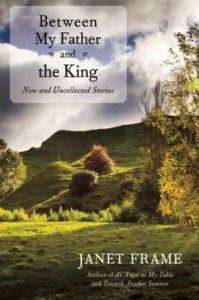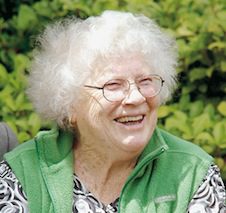
Raymond Carver wrote, “Every great writer makes the world over according to his own specifications” and “has some special way of looking at things.” Janet Frame’s brilliant particularities include her portrayals of grief parsed with humor, her children’s wonder and ferocity, and her aching illuminations of outsiders and the lonely. Carver and Frame were very different writers in regard to voice and vision, but both placed a premium on the cut of truth, no matter how painful and sometimes, simultaneously, comic.
Janet Frame, who wrote and lived in New Zealand most of her life, once remarked, “Posthumous publication is the only form of literary decency left.” More than half of the stories in Between My Father and the King, written over a span of four decades, were not published in Frame’s lifetime due to a variety of circumstances. Despite that, she was prolific, and during her career published eleven novels, three short story collections, a book of poetry, and the three autobiographies on which the film An Angel at My Table was based. She won numerous international literary awards to which she reacted with extreme humility. She said, “I am not really a writer…just someone who is haunted, and I will write the hauntings down.”
During her twenties, Frame was misdiagnosed as a schizophrenic and subjected to more than two hundred shock treatments. Following years of psychiatric hospitalization, she was scheduled for a lobotomy that was cancelled just days before the procedure when her debut publication of short stories was unexpectedly awarded a national literary prize. A number of the stories in the collection reflect her experiences during this period.
In “A Night at the Opera,” patients in a psychiatric hospital are promised a screening of the Marx Brothers film, but only while it is still daylight and they are unable to see it. One of Frame’s recurring themes is the examination of characters whose lives are shaped by actions imposed upon them for their own “well-being,” but which entirely defeat the purpose. The patients yearn for candy, and a nun who works in the ward returns with tins of sweets that are:
thrown in handfuls into the middle of the dayroom, prompting a lively scramble and a few black eyes and bleeding noses. They were paper sweets, with mint intestines, and words written on the outside of the wrapper, ‘The Sweet for All Times and All Places.’
Later, after undergoing “head operations,” these same patients “moved stiffly, like blue snowmen.” Frame’s writing can be by turns, rapturous, chilling, and brutally comic.
One of the most powerful stories in this striking collection, “Gorse is Not People,” is a disturbing, beautifully observed story about a young woman, a dwarf, who is wrongly institutionalized and believes she will be released on her twenty-first birthday.
Since her tenth birthday, she had lived in a mental hospital, in the ward where they put people who were strange in shape and ways—Sickly yellow grass curled up through the cracks in the concrete, but no geraniums blossomed there. Should not children have geraniums, the dry, dusty flowers with the red stony-velvet smell?

The story was rejected for publication by the literary journal Landfall and caused Frame great artistic distress. She asked, “What could I do if I didn’t write? Writing was to be my rescue.” The story was finally published in The New Yorker in 2008, four years after her death.
Other stories reveal the comic cracks in human behavior, the small, quiet moments of desperation. “Bone in the Throat” presents a man determined to shuck off his profession and confining life in a small New Zealand town. He jumps on a train with plans to leave it all behind. Yet upon meeting the proprietress of a seaside hotel, he immediately “uses the habitual and hated detergent, the guaranteed whitewash of respectability,” declaring, “I’m a school teacher, you know.”
He thought, Now she’ll be proud to have me. I’ve got to trade on something, some secret handshake or badge or poppy on my lapel to give myself some standing.
A number of the stories feature loners or outsiders. In “Gavin Highly,” a man lives in a condemned hut crammed with books he believes to be of great monetary value. The book appraiser tells him that “the value is inside you, and I’m afraid you cannot take that…to the auction rooms and call for bids upon it.” Another story, “In Alco Hall” focuses on a teenage girl, Joan, who is warned to stay away from a neighborhood pariah, Mrs. Gull, who “camped rather than lived” in her house, dropped her cigarette ashes in the cake mix while baking, and “led young girls astray”—yet Joan finds Mrs. Gull is the only one who understands her.
Frame wrote with great emotional acuity about family. She inhabited her child narrators with longing, fierceness, and complexity. The narrator in “The Plum Tree and the Hammock” states, “In families, you see, there is a kind of animal construction that makes the eldest turn, like a creature to its tail, to bite or lick the youngest.” In “The Birds of the Air” a young girl realizes that her mother, who only has one row of teeth and needs money for dental work, “had paid the rent so that five weeks in our house were, in a strange way, equal to my mother’s bottom teeth.” Her children are never precious, only urgently invested in circumstances beyond their control—watching, and waiting, trying to solve the curious algebra of adult actions.
Most of the stories are between five and ten pages with a few longer than that. On occasion, I stopped to consider why a particular story ended so quickly when the premise and pacing could have sustained a longer piece. Still, Frame’s ability to distill an experience and sometimes an entire life into a few pages was remarkable. Her characters yearn, and ache, and are overtaken by wonder. She was an emotional cartographer of the highest order, one who deeply understood the inner workings of the human heart.




